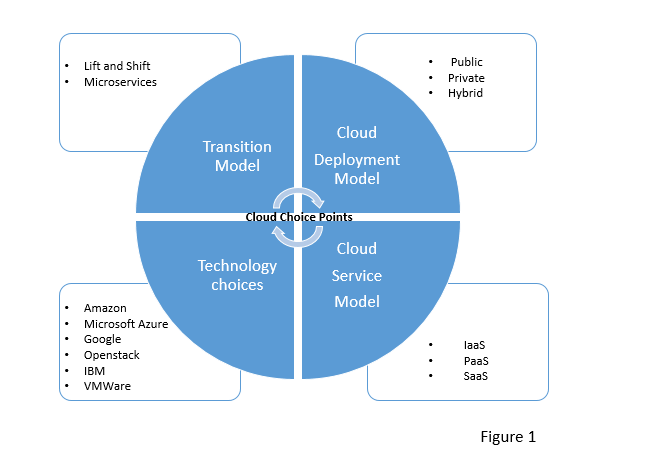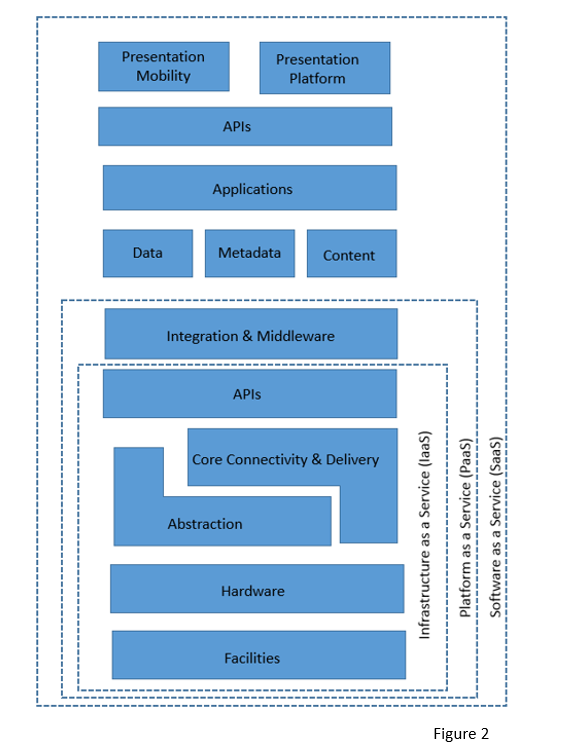Decided to make the move to the cloud? Yet, feel daunted by the technology choices available? Despite the limitless options, there is little guidance on how to go about making the right decision. This article focusses on clearing up the skies on the available cloud computing technologies to help you with better decision-making.

Follow the Cloud Choice Points
Any business that intends to embark on the cloud journey will have to make decisions based on the choice points detailed in Figure 1 below. This diagram highlights every cloud computing choice point for infrastructure, cloud operating model, transition choices and technology stack.

What’s Your Cloud Deployment Model?
The choice here is mostly a trade-off between cost of infrastructure and security of data. While the public cloud is the most cost-effective option, security of the data is a concern here. The private cloud involves a higher initial infrastructure cost with assured security of data, as the infrastructure is owned by the organisation.
If you want specific applications to be hosted on the cloud while more secure applications delivered on premise, then hybrid cloud is the preferred option. Importantly, the technology which enables data and application portability has to be robust, so that it can leverage hybrid clouds.
Choose Your Cloud Service Model
You must review the applications that will be migrated to the cloud, in order to choose the right cloud service model. More often than not, the target service model will be an amalgamation of the IaaS, PaaS and SaaS service models.
For applications that are not core to the business, a SaaS model should work. IaaS is an option when high scale and performance requirements are important. It is for organisations who want greater control over the performance and security of the applications. While PaaS involves an upper limit to scale, it promises quicker time to market, as the developers of the solution only need to focus on the business functionality. This is because the entire infrastructure is abstracted. Figure 2 below is a Cloud Security Alliance view of how each service model is structured.

Which Transition Model to Take
Several different models and deployment strategies have emerged in the cloud computing landscape over the past few years. Each type of cloud service and deployment method provides businesses with different levels of control, flexibility and management. Therefore it is important to understand the differences between IaaS, Paas and SaaS, as well as what deployment model and strategies can help businesses in making a decision on services that meet their needs.
There are various ways in which applications and services can transition to the cloud. Which is why, it is logical to state that not all applications are candidates for the cloud. Only a subset will be fit for transition and move to the cloud. When building a cloud transition strategy, the key to success involves understanding which applications must be moved to cloud architectures, when and how. It is important to review the overall enterprise application needs and determine which of these will benefit the most from the transition.
One essential prerequisite of this enterprise level strategy will be application portfolio rationalisation. It will help with creating a roadmap to transition applications and services to the cloud.
There is definitely no one-size-fits-all answer when it comes to choosing the transition model. Two very high level approaches to transitioning applications and services to the cloud are lift and shift and re-architect (or re-platform). If businesses want to add business capabilities that cloud architectures help to achieve such as performance, security, scalability, global reach and moving to agile models such as DevOps, then re-architecting with micro services architecture is the way forward. If there are applications which will not be revamped or retired, the option should be to lift and shift or re-platform at the best.
Make the Right Technology Choice
Organisations that embark on the cloud journey have to make decisions around a technology partner. It is an important decision, as it determines the cloud transition journey. Once clarity on the purpose and objectives of the cloud transition is achieved, the technology partner delivers this alignment.
Technology partners have individual capabilities around IaaS, Paas and SaaS. This choice becomes relevant once the cloud model is adopted. For instance, Salesforce has a strong SaaS presence in CRM. For those looking at a SaaS model for CRM, Salesforce will work. Whereas VMware which has a strong IaaS presence, will suit businesses whose objective is to lift and shift existing application on the cloud. Microsoft and Amazon have a strong presence in all three areas of IaaS, Paas and SaaS with Google steadily catching up. Openstack remains the open source choice for IaaS, as also IBM with its Softlayer acquisition.
Figure 3 below summarises the capabilities provided by leading cloud platforms.

Challenges with Moving to the Cloud
Other than arriving at the choice points, there are quite a few challenges that businesses must overcome in order to move to cloud architectures.
Prior to the Move
- Organisation Readiness: The shift to the cloud is not just a technology shift, but a shift in user experience. Applications need to be revamped for the cloud, which impacts user interaction with the applications. There are times when the application is live in both environments with past records in the old architecture and new records in the cloud architecture. This causes a dent in the user experience of the application, creating resistance to change, which the organisation must handle by managing expectations and focussing on the bigger picture of cloud transition.
- Change Management: A lot of planning goes into identifying the applications that are ready to be migrated to the cloud and those that require further enhancements before the move. Essentially, the migration has to be carried out on a business as usual basis. Therefore change management planning and execution at the organisation level becomes the key challenge. All the heads of department must buy into the change management plan, own and execute the change
- Security and Privacy: Security is the number one concern for an organisation moving its data to the cloud. Organisations are reluctant to handover data to third party providers.
- Workloads on the cloud: How does an organisation arrive at the correct capacity of cloud infrastructure investment? The return on investment has to be achieved to prove the cost benefits of cloud migration. Therefore organisations must understand the right workloads on the cloud to avoid loss of ROI.
Post-Move
- Skillset Locking: Even though the move to the cloud feels like switching the services on and off, organisations must think about management of the applications two years down the line, if the cloud service is no longer available. What capabilities does IT need to build in order to avoid skillset locking?
- Scaling and Modernising: Questions will be asked about the ROI. Therefore the organisation must analyse, scale and modernise the cloud applications, in order to optimise performance and leverage ROI.
- Capacity Planning and Analytics: It is important to invest in monitoring capacity and performance management tools, to gauge the workloads on cloud.
Enterprise architectures are undergoing dramatic change. From public cloud platforms, PaaS platforms and IaaS applications, everything is changing simultaneously. Therefore the decision around which cloud platform to opt for becomes a critical question in the cloud transition journey. This is because the cloud platform vendor is, in effect, a partner in the journey to enable businesses to fully embrace the cloud.
Acknowledging that the change is huge will require dedication and discipline to transition into this new world. It will ensure that those piloting these enterprise applications experience a smooth ride, rather than a bumpy one while taking a walk in the clouds.
At Mastek, we have helped our clients to successfully evaluate and adopt cloud platforms. Whether you’re planning to make the move to the cloud now or in the future, connect with us at info@mastek.com to find out how we can help your business save time and money while making this important decision.

